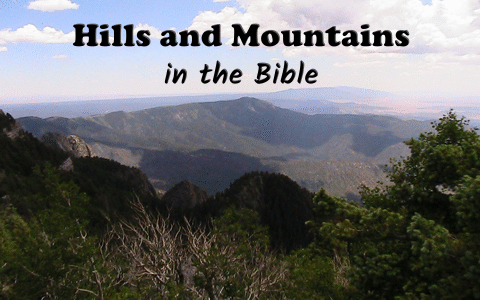I love the mountains and am so blessed to live near some beautiful ones. Here in Albuquerque, New Mexico, located southeast of the valley are the Manzanos (Manzano is the Spanish word for “apple tree”. There are many apple orchards up there). You can find the Manzanita Mountains just to the north of the Manzanos and the beautiful Sandia mountains (on the north side of the of the Manzanitas, north of the Tijeras Canyon) border the east of the Albuquerque high desert valley. The word “Sandia” is the Spanish word for “watermelon”. Most believe the mountains are so named because of the red glow at sunset and the green of the cedars, Douglas firs, cypresses and other pine trees that line the top of the hills. However, it is more accurate to believe that they got the name Sandia because when the land was settled by the Spaniards in 1540, the Indian Pueblo had many, many squash gourdes growing that looked like watermelons.

A view from Sandia Peak, Albuquerque, New Mexico. Elevation 10,678 feet
God made hills and mountains all over the world and there are many that we can see in the Bible. Let’s look at what hills and mountains are named in the Bible.
Abarim – located east of Jordan, southeast of the Dead Sea
Numbers 27:12, Numbers 33:48 and Deuteronomy 32:47
Ararat – located in east Turkey
Well known as the place where Noah’s ark rested. Genesis 8:4 and Jeremiah 51:27
Bashan – located in Iran
Psalm 68:15
Bethel – possibly located in the West Bank, Israel (Judea and Samaria)
1 Samuel 13:2
Carmel – located in northern Israel, ranging from the Mediterranean Sea and southeast
Where Elijah’s sacrifice occurred. 1 Kings 18:19, 2 Kings 2:25, Isaiah 33:9, Jeremiah 46:18 and Amos 1:2
Ebal – located in the West Bank, Israel (Judea and Samaria)
Deuteronomy 11:29-27 and Joshua 8:30-33
Ephraim – located in Israel, extending from Bethel to the plain of Jezreel
Joshua 17:15, Judges 2:9; 4:5; 7:27; 18:13, 1 Kings 12:24 and 2 Kings 5:22
Gerizim – located in the West Bank, Israel (Samaria), southern valley
Deuteronomy 11:29; 27:12; Joshua 8:33 and Judges 9:7
Gilead – located east of the Jordan River, in Jordan
Genesis 31:21, 25; Judges 7:3 and Song of Solomon 4:1
Horeb (also known as Sinai) – possibly located in the Sinai Peninsula of Egypt
Where Moses saw the burning bush. Exodus 3:1, Exodus 16:1; 19:11; 24:16, Acts 7:38
Moriah – located in Jerusalem between Mount Zion (to the west) and the Mount of Olives (to the east)
Known as the place where Abraham sacrificed Isaac. Genesis 22:2, 2 Samuel 24:18, and 1 Chronicles 21:18
Olives (Olivet) – located in East Jerusalem
The place from where Christ ascended to Heaven. Matthew 21:1; 24:3; 26:30, Luke 21:37 and Acts 1:12
Seir – located in the territory of Edam, presently controlled by Jordan
Genesis 14:6, Deuteronomy 1:2; 2:5 and Ezekiel 35:2
Sinai (also known as Horeb) – possibly located in the Sinai Peninsula of Egypt
The place where the Law was given. Exodus 3:1, Exodus 16:1; 19:11; 24:16, Acts 7:38
Tabor (Herman) – located in Israel, west of the Sea of Galilee
The place where Christ was transfigured. Judges 4:6, 14; 8:18, Psalms 89:12, Jeremiah 46:18 and Hosea 5:1
Zion (Sion) – located in Jerusalem
2 Samuel 5:7, 1 Kings 8:1, Psalms 87:2, Romans 11:26, Hebrews 12:22 and Revelation 14:1
Do We Need Mountains?
Since God created them, of course we need them! But of what benefit are they to us, even today? Did you know that mountains make up over one quarter of the earth’s land? Not only that, over 700 million people around the world live in those mountains. In some areas, such as the desert, the rain fall, and snow melt on the mountains are essential to crops, animals and even people living down below. In areas, such as the desert in Albuquerque, we see something known as a “rain shadow”. This is because on the Leeward side of the Sandia mountains (the wind protected side of the mountain) we get far less rain than on the Windward side of the mountain. When it is raining on the other side of the mountain, many times we see the rain even over the valley, but it just never comes to the ground. But God is good to send us a rainy season (called the monsoon season) which can last anytime between June 15th and September 30th each year. During this time, we get “big” rain nearly every day. I am so thankful that God thought it all out, otherwise we would go hungry and maybe even die of thirst down here in the desert!
Take a look at this related article: Meteorology in the Bible
Resource – Scripture quotations are from The Holy Bible, King James Version. Photo “Sandia Peak” courtesy The Williams Family.








 Welcome to What Christians Want To Know! The mission of this site is to equip, encourage, and energize Christians. Look for regular updates including Bible Verses, Bible Stories, Christian Quotes, Christian Answers, and much more. Find out
Welcome to What Christians Want To Know! The mission of this site is to equip, encourage, and energize Christians. Look for regular updates including Bible Verses, Bible Stories, Christian Quotes, Christian Answers, and much more. Find out 









